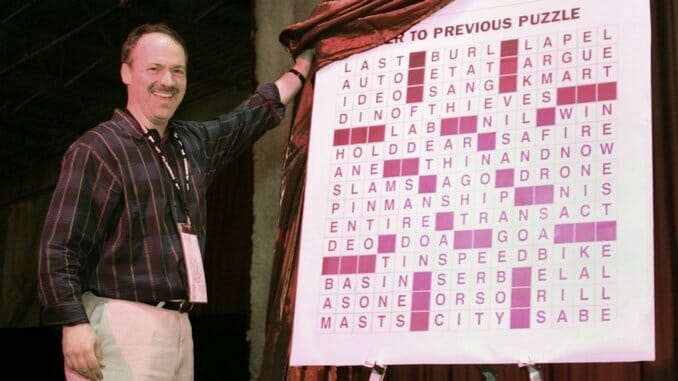The New York Times Crossword Puzzle Is Getting Easier. Is That a Good Thing?
Photo courtesy of Getty Images
I’ve had a suspicion for a few years now that the New York Times crossword puzzle has become far easier, but the only evidence was that my solving times had improved measurably despite the fact that my late-30s brain now moves at the speed of sludge. How could I be performing at a higher level today than 10 years ago, when I was a sharp 20-something whose synapses fired like lightning? Yes, it’s technically possible I am getting better at crosswords in general—this conclusion would appeal to my ego—but the futility of the wilting brain in all other walks of life made it seem doubtful. I mean, I have to sit and ponder things now, like an old man on a porch swing. Why would I be faster at crosswords?
And yet, a decade ago it would have been a real achievement to complete the three hardest days of the puzzle, Friday through Sunday, with no errors. The first time it happened, it was a very big deal for me, nerdy as that sounds. Back then, a tough Saturday puzzle could take up to an hour. Today, it’s extremely rare that a puzzle will stymie me for longer than 20 minutes, Saturday or otherwise, and when it does it’s usually because I’m tired or buzzed or both.
Finally, a few weeks ago, I decided to run a live experiment, and for help I enlisted some friends with whom I spend 10-15 minutes each day talking and complaining about Will Shortz’s puzzles on a Slack chat room. Some are on roughly equal footing with me, and most are much better—the kind of geniuses who routinely solve Friday and Saturday puzzles in under 10 minutes. To test my hypothesis, I asked them to complete the following act of unpaid labor with me (unpaid for them, that is):
Finish three weeks of Thursday-Saturday puzzles from 2021, three weeks from 2015, three weeks from 2005, and three weeks from 1995.
That’s nine puzzles from each era, and 36 overall, which feels like a decent sample size. Some of my friends completed every puzzle, while some (like me) completed only a portion. Here’s a breakdown of how our times looked by era (asterisks indicate that the solver finished all puzzles):
The headline here is that for every single one of us, 2021 was the easiest slate. I’ll spare you the more granular breakdown, but it was the same if you looked at any individual day. The lower our skill level, the more pronounced the difference, and in fact my times are the least reliable of all, because on several of the older puzzles, I gave up after 45 minutes (even that felt like a lot of wasted time) and assessed myself a penalty. To answer my own question from the first paragraph, those puzzles I found so difficult in my 20s are still just as difficult today. If I had stuck it out for the final sections, I believe I would have completed the puzzle eventually, but the time would be even worse. In that way, I’m almost a perfect test case, because my level is such that I’ll almost never fail to solve a modern puzzle, but take me back 10 years, and some will stump me. I’m an historical tweener.
(There’s one caveat here, which is that topical references will obviously be much easier in the 2021 puzzles, since, well, we live in the year 2021. That said, solving a crossword is more about recognizing letter patterns and general knowledge, and the few pop culture clues sprinkled throughout—though easier in 2021—aren’t numerous enough to make a huge difference, and are certainly not enough to explain the massive time disparity between eras.)
The numbers showed what they showed, and our collective anecdotal experience was unanimous: Things have gotten much easier. Why? Hard to say, but I suspect Steve Melnick, one of the solvers in the table above, pinpointed the likeliest scenario for what he called “The Great Easing.”
“It’s the bane of all public companies,” he wrote, “the need for growth. The crossword is a profit center. Growing means expanding the profitable base with easier, more modern puzzles, even at the risk of alienating hard-line traditional solvers who have memorized every 4 letter river in the world.”
The question that follows is whether the Great Easing is a good thing. On that, to my mild surprise, our opinions were also mostly in accord.
